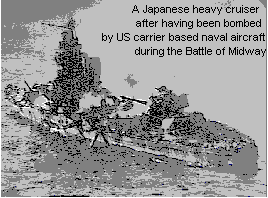The War in the Far East,
The Japanese Pacific War,
![]()
The War in the Far East,
The Japanese Pacific War, |
|
A major element in this strategy was a pre-emptive attack upon the
USA Pacific Fleet at Pearl Harbour (Hawaiian Islands).
On 7 december 1941 363 carrier-borne aircraft attacked the Fleet
at anchor. Major damage was inflicted on battleships, airfields and
port installations. Japanese losses were small.
On 8 december war was declared on Japan, the attack was welcomed with shock and indignation in the US. Three days later Germany and Italy declared war on the US.
Singapore seem to be an impregnable fortress. Its rapid surrender to the Japanese invasion was a blow to British prestige and her empire in the Far East. The Allies were badly prepared to defend their land in the Far East. There were too many bad defended airfields and a few aircraft. The forces at land lacked in tropical conditions, training and equipment for fighting.
The Singapore and Hong Kong naval bases were far from secure and the British naval reduced. Japan made the best of limited resources. Japanese land forces excelled in operation in difficult terrain, recognised the importance of amphibious operations and air support, fast and relentless advance slow down Allied morale and ensured Japanese victory.
 Control of the sea and air was vital in the Pacific. Whoever
controlled these, could dominate the ocean. In 1942 in the battles
of the Coral Sea and Midway, the US won the initiative. The battles
were most fought between aircraft carried on board ships, raged
over miles of sea. They demonstrated the importance of the aircraft
carrier in naval warfare.
Control of the sea and air was vital in the Pacific. Whoever
controlled these, could dominate the ocean. In 1942 in the battles
of the Coral Sea and Midway, the US won the initiative. The battles
were most fought between aircraft carried on board ships, raged
over miles of sea. They demonstrated the importance of the aircraft
carrier in naval warfare.
The Japanese halted, but then draw back throughout their Pacific empire. General MacArthur's forces fought back through New Guinea to the Phillippines, while other operations recaptured the Solomon Islands. In the Central Pacific, Admiral Nimitz's island-hopping amphious assaults took them to Japan.
![]()